I thought I was a bit of a latecomer to Twitter when I jumped on board two years ago but given the growth rate since then – it’s gone from 100 million tweets in Q4 of ‘08 to 4 billion tweets in Q1 of 2010 – I appear to be a relative sage of the Twittersphere.
Having now reached a point where I consider Twitter a “must have” business tool, I’m enjoying encouraging others to seek out the same benefits. However it’s always difficult to articulate the virtues in a casual conversation so here are 20 quick tips on how I’ve made it successful in my role as a software architect.
1. Don’t try and understand it all before you get started
I had an admittedly slow start and as evidenced by my first tweet, I really had no idea what the practical value of Twitter was:

Two tweets and 14 months later I finally decided to make a concerted effort at trying to derive a business value from Twitter in my professional capacity. Some people find it a bit daunting to sign up to a service they know little about (privacy and security concerns don’t help), but you can always jump in without disclosing anything about yourself beyond an email address and even that isn’t made public.
So don’t try and understand all the ins and outs of being a tweep before getting started. You’ll never fully comprehend it without diving in and experiencing it firsthand.
2. Make a two month commitment
I made a conscious decision to actively use Twitter for two months, regardless of how futile it might seem along the way. As evidenced by the previous point, I honestly had not idea of the practical value and I’m a technical person who’s meant to know these things!
It’s just as well because it honestly took me a good eight weeks to have a positive professional impact. During that time I not only had to learn the functional mechanisms of Twitter but I had to learn how to prioritise it around my professional life. When I used it, how I used it and what I used it for were all new discoveries which took time to get to grips with and I continue to change my habits to this day.
So this is a critical first step; accept what you don’t yet understand, acknowledge it is a tool with enormous potential and make the commitment to give it a fair go.
3. Get the right tools
You can always read Twitter in the browser at twitter.com but there are plenty of apps around which do a far better job of it. One thing Twitter did very well early on is to ensure a comprehensive API model was made available to encourage the development of third party apps. There are numerous offerings for most connected devices out there and most have the same fundamental behaviours although implementations differ.
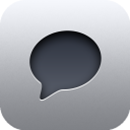 Most of my reading is done on the iPhone for which I use Tweetie. This is a great little app which only costs a few dollars and is very intuitive to use. It also won a 2009 Apple Design Award due the very neat, fluent use of iPhone usability features. One final point on Tweetie; last week Twitter announced they had acquired Tweetie so it appears to have become a first class Twitter citizen rather than remaining a third party offering. Certainly it now appears to be the iPhone app of choice.
Most of my reading is done on the iPhone for which I use Tweetie. This is a great little app which only costs a few dollars and is very intuitive to use. It also won a 2009 Apple Design Award due the very neat, fluent use of iPhone usability features. One final point on Tweetie; last week Twitter announced they had acquired Tweetie so it appears to have become a first class Twitter citizen rather than remaining a third party offering. Certainly it now appears to be the iPhone app of choice.
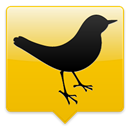 As for the desktop, it’s hard to go by Tweetdeck. This app seems to have almost become the ubiquitous desktop Twitter client based on its predominance. In fact even organisations like Sky News have begun installing Tweetdeck on all its newsroom computers. Of course there are others – Seesmic pops up a lot – and the great thing about these clients is that the vast majority are free and you can always try a few of them at once without doing any damage to your account.
As for the desktop, it’s hard to go by Tweetdeck. This app seems to have almost become the ubiquitous desktop Twitter client based on its predominance. In fact even organisations like Sky News have begun installing Tweetdeck on all its newsroom computers. Of course there are others – Seesmic pops up a lot – and the great thing about these clients is that the vast majority are free and you can always try a few of them at once without doing any damage to your account.
For those who don’t want to install a dedicated app or can’t for various reasons, there is always twitter.com and of course the mobile web version although the latter restricted in functionality such as the native retweet feature. Do yourself a favour and install a decent client; here’s a whole bunch of business justification if you need it:
4. Start tracking industry news
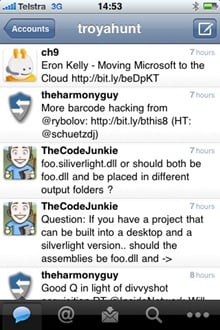 There was a time where I used to receive all the industry news I needed via email. On a regular basis I’d receive nicely formatted HTML emails from a variety of sources and that did me just fine until RSS became ubiquitous. With news syndication services now common and a decent reader I no longer had general broadcast news mixed up with direct personal communications. This was great as it meant I could choose specific times to digest industry information in a passive fashion and not have it distract me during periods where I wanted to focus on specific business tasks.
There was a time where I used to receive all the industry news I needed via email. On a regular basis I’d receive nicely formatted HTML emails from a variety of sources and that did me just fine until RSS became ubiquitous. With news syndication services now common and a decent reader I no longer had general broadcast news mixed up with direct personal communications. This was great as it meant I could choose specific times to digest industry information in a passive fashion and not have it distract me during periods where I wanted to focus on specific business tasks.
Twitter has now all but replaced my RSS dependence simply because it allows me to consume a far greater volume of information at a much faster rate than email or RSS and rapidly discard irrelevant information. It facilitates this because rather than needing to trawl through various feeds of information I have a single aggregated source of information from sources I’m generally interested in.
5. Get over not having any followers
One myth you get over pretty quickly is that you need lots of followers to get any value from Twitter. You don’t. At the time of writing I have 129 followers, many of whom I assure you have absolutely no interest in what I have to say or even work in the same field.
Plenty of people are using automated services like Twollow to immediately follow anybody tweeting particular keywords but it’s quite obvious, at least based on people who have obviously auto-followed me, that more often than not they have absolutely nothing in common with me.
The reality is that being followed is but one way to have your voice heard. Assuming your tweets are not marked as private (and if they are, this post is mostly irrelevant to you), your voice is being publicly broadcast and in many instances it will still be heard. More on that a little later.
6. Most of your followers aren’t interested in what you’re tweeting
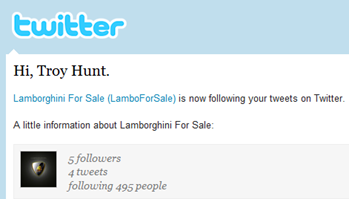 As I suggested in the previous point, you tend to accumulate a lot of followers who are auto-following based on keywords. One tweet from me last week about the Asus Lamborghini laptop resulted in me being followed by @LamboForSale.
As I suggested in the previous point, you tend to accumulate a lot of followers who are auto-following based on keywords. One tweet from me last week about the Asus Lamborghini laptop resulted in me being followed by @LamboForSale.
I’d love to buy a Lamborghini, I really would (the four wheeled version, not the laptop!), and I enjoyed looking at the cars in the 4 tweets this account made but I can absolutely, positively guarantee you that this follower is not interested in my insights about OData or the Stack Overflow API private beta. They’re no more interested in my tweets than @LostDogsHome, @FreeAdsCoach or @WildChildLily are. So in short, don’t use the number of followers alone to judge the interest or relevance of a Twitter account.
7. Get questions answered – fast
So you have no followers to begin with and the ones you do acquire are mass marketers or porn stars; how do you actually get through to an audience? Mostly it comes down to key words and saved searches.
Let me demonstrate: A few weeks back I asked a question about DotNetNuke hosting:
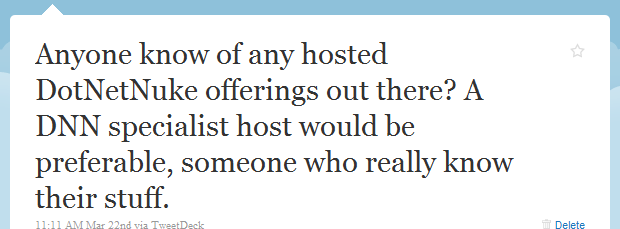
Two minutes later – let me just repeat that for impact: two minutes later – I had an answer from @nokiko:

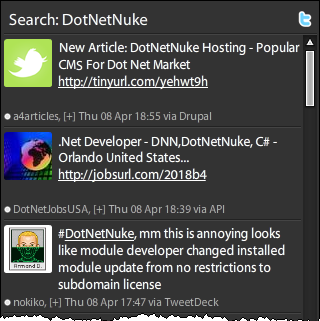 This particular user was obviously pretty interested in DotNetNuke and likely had a search set up for this keyword. As you can see from the image on the right, this can be added to Tweetdeck as another column returning only the search result so it’s very easy to surface search data in real time.
This particular user was obviously pretty interested in DotNetNuke and likely had a search set up for this keyword. As you can see from the image on the right, this can be added to Tweetdeck as another column returning only the search result so it’s very easy to surface search data in real time.
The point is that even with no followers you can still reach out to a very broad range of Twitterers if you’re tweeting about topics of interest. I’ve got a heap of other examples of very similar experiences and it’s gotten to the point now where I tend to tweet first and put in the legwork after. It turned out the answer I got above was the best possible result and the answer literally took two minutes. What a fantastic result!
8. Stay on topic
Something I did very early on was to consciously elect to use Twitter as a business tool rather than using it as a personal broadcast mechanism. I found that people I was following who regularly tweeted about non-professional activities – such as what they were eating – caused me frustration as it diluted the quality of information I was getting from the service. This is not to say that anything other than bland techie posts should be broadcast, it’s just that I found unless the balance leaned very heavily towards professional topics the person became “noise” and I’d unfollow them.
I’ve tried to work towards at least 80/20 professional versus personal tweets. Out of the average 10 tweets per day I currently make I’m happy to have a couple which may not be directly related to software or technology if they give some sort of insight to my character and may actually be interesting to people (such as my son’s first swimming lesson this weekend).
The majority of personal information I keep to Facebook because not only is the service more conducive to the sort of information I would share there (photos, videos), it’s also not a public broadcast mechanism and I have some control over who’s viewing my content. It becomes my personal social network whilst Twitter is my professional version. As a result, very, very few of the people I connect with on Twitter are Facebook friends.
9. Turn it off
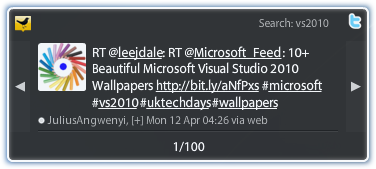 Twitter can become an intrusive beast, particularly when using clients like Tweetdeck which send out notifications about tweets from every single person you’re following (see image to the right). Tweetdeck also loves to let your ears know there’s something new by making a tweeting noise by default. Pretty soon it feels like you’re in an aviary and it will cause you to lose focus (the audio is also the very first thing I turn off after a new install).
Twitter can become an intrusive beast, particularly when using clients like Tweetdeck which send out notifications about tweets from every single person you’re following (see image to the right). Tweetdeck also loves to let your ears know there’s something new by making a tweeting noise by default. Pretty soon it feels like you’re in an aviary and it will cause you to lose focus (the audio is also the very first thing I turn off after a new install).
Just like many people consciously elect to ignore email or instant messaging during key periods of concentration, usage of Twitter need to be selective or your productivity gain from the positive attributes of the tool will quickly be eroded by all the noise it’s making – both literally and figuratively.
10. Avoid one-on-one conversations
It’s very easy for a tweet to descend into a one-on-one public discussion with someone but it usually provides little value to your other followers. Banter between individuals quickly becomes “noise” for everyone else and dilutes the value you bring to your followers, even if you only have a few who are interested in what you have to say.
Twitter provides a direct messaging feature for this sort of discussion and of course there’s still good old email. Take the one-on-one discussions off the public broadcast mechanism and keep your timeline on topic and relevant to the bulk of your followers.
11. Build networks with influential peers
One thing Twitter does really, really well is to connect you with others in your field. I’ve found many of the influential people who work in my fields of interest extremely approachable and often very appreciative of feedback. Case in point:

Jeremiah Grossman is the founder and CTO of Whitehat Security - “the leading provider of website risk management solutions” – and a preeminent contributor to the Open Web Application Security Project (OWASP) which many consider to be the bible of software security. I was doing some work in the application security space so who better to get some reference material from?

Jeremiah ended up following me and I had a number of subsequent Twitter discussions with him where he provided some really excellent information about application security. He was also kind enough to retweet a question of mine so suddenly the 129 followers I had became insignificant as the several thousand followers he had got my message.
I’ve had similar interactions with guys like @KeithElder from the Deep Fried Bytes podcast and @jbrinkman, a co-founder of DotNetNuke Corp. This isn’t intended to be a name-dropping exercise rather an illustration of how Twitter can so easily bring you close to the people that can make a positive impact on your job function.
12. Maximise your downtime
I find myself with a lot of downtime which is normally rendered pretty useless beyond being left alone with my own thoughts. When I say “a lot”, I’m talking about times where I’m standing in a queue, waiting for a coffee, commuting or any number of other tasks where I’m normally rendered pretty idle. This probably only adds up to 15 or 20 minutes a day but it’s enough to flick through most of the tweets from those I’m following. Besides, that’s 5 whole days every year – who wouldn’t like to have someone give them this amount of time back to do something useful with?!
Obviously to make this work you need a mobile device but with Twitter clients being available for all popular phones these days and Twitter Mobile Web being available for those where for whatever reason only a browser is available, it’s easy for anyone to get connected these days.
13. Use favourites to manage your reading time
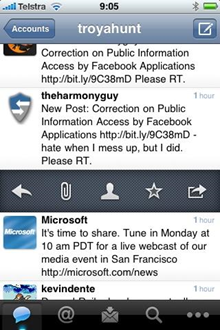 Having a 140 character limited digest of news makes it really easy to quickly flick through what’s going on. Hopefully some of the dozens of tweets you see each day actually contain information worth taking a bit of time to read thoroughly, usually because they link through to other resources such as blogs or videos. As I mentioned above, I try and use my downtime to quickly scan through tweets but standing in a line at cafe is not the right place to read and properly digest much of the information tweets refer to.
Having a 140 character limited digest of news makes it really easy to quickly flick through what’s going on. Hopefully some of the dozens of tweets you see each day actually contain information worth taking a bit of time to read thoroughly, usually because they link through to other resources such as blogs or videos. As I mentioned above, I try and use my downtime to quickly scan through tweets but standing in a line at cafe is not the right place to read and properly digest much of the information tweets refer to.
I use favourites to quickly tag tweets of interest while I’m browsing on the iPhone so I can come back to them once I’m at a PC and can take my time digesting the information. Most Twitter clients – including Tweetie which you’ll see on the right (swipe the tweet and hit the star icon) – make it very easy to mark the tweet then move on with your reading. Once I get back in front of a PC and have some allocated time for reading I’ll go through each favourite then remove it.
Just remember though, every tweet you mark as a favourite is publicly visible so you might want to be a bit selective with your choices. A tweet with information about that odd rash you’ve developed may not be something you want to flag as interest for the world to see!
14. Don’t rely on Twitter data integrity or search functionality
One thing you learn very quickly when searching for information on Twitter is that results are erratic to say the least. There have been times where I’ve tweeted something then gone back to find it later and simply couldn’t locate the tweet. Even the search is pretty inconsistent and won’t necessarily find tweets which might still be in the system:

If a tweet is worth coming back to in the future, flag it as a favourite or even bookmark it in your browser, just don’t expect to be able to search for it and find it again. I’ve recently spent time continually hitting the “more” button on the Twitter website then using the browser’s find feature to search through page contents. This is not how search should be done!
15. Don’t try and read everything
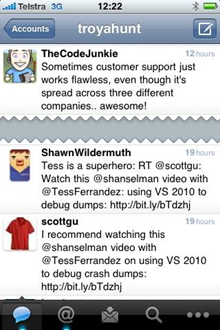 Twitter is not email and you don’t need to stay on top of everything those you are following are saying. For a while there I felt I was missing out if there was a gap in my Twitter timeline (i.e. overnight), but the reality is that unless someone is mentioning you directly – in which case most Twitter clients will highlight this to you – missing hours or days of tweets simply doesn’t matter.
Twitter is not email and you don’t need to stay on top of everything those you are following are saying. For a while there I felt I was missing out if there was a gap in my Twitter timeline (i.e. overnight), but the reality is that unless someone is mentioning you directly – in which case most Twitter clients will highlight this to you – missing hours or days of tweets simply doesn’t matter.
This comes back to Twitter being a public broadcast mechanism; most of what is said by those you’re following is not explicitly intended to reach you. I get the paper delivered each weekend (the one made of dead trees), but I don’t feel compelled to read every article or even open every page. It’s the same deal with Twitter.
If you do manage to read everything those you’re following are tweeting 24x7, chances are you’re either following a narrow set of people or they as producing a limited amount of content. Either way, you’re probably not getting the most out of Twitter.
16. Don’t be afraid to stop following people
Treat the concept of following someone as a transient state; just because someone is tweeting about subjects that interest you today doesn't mean it will still be the case tomorrow. I find myself recycling many of those I follow on a pretty regular basis either because I had a fleeting interest in what they had to say (perhaps in the scope of a particular project), or I find their ratio between professionally relevant information and noise gets out of balance.
Unlike when you elect to follow someone, unfollowing them will not send a notification to that effect so don’t be concerned about hurting anybody’s feelings! If you don’t cull the people you follow you will quickly find Twitter becoming unwieldy as you continually follow new people.
17. Porn stars will follow you – get over it
I’ll be honest and say I had an issue in the beginning when sex industry related tweeps would follow me, not due to any specific moral objections but because their profile images would appear on my list of followers. Not a real professional image!
The thing is though, we come back around to Twitter being a public broadcast mechanism and as such people in the public domain will “follow” you. The air-quotes are intentional because the reality is that these people have absolutely zero interest in you and following you. All this activity does is consequently generates a “you’re being followed by…” email which is simply spam. Ignore it and don’t bother blocking them because it’s a cost on your time and achieves absolutely nothing of tangible value.
18. Learn to be concise – 140 characters is still a lot
It might not seem like much, but most messages can be amply conveyed in 140 characters without reverting to SMS Language. Twitter actually forces you to consider what the crux of your message is and distil it down into very direct, concise terms.

Of course Twitter has only become so readily digestible because of the short nature of the messages. Still, many Twitter clients support features such as URL shortening (usually reducing any URL to 20 characters or less) and even message shortening which will attempt to abbreviate some words.
19. Tweet carefully and remember, you’re on public record
All the same considerations regarding public messages apply when you’re tweeting as they do when you’re blogging or posting information to a public forum. In particular, consider the privacy and disclosure aspects of the information you’re tweeting if it relates to a third party.
Many companies have corporate blogging policies which cover public communication networks such as Twitter. I take the approach of ensuring I never tweet anything – directly work related or not – I wouldn’t be happy to share with everyone within my organisation and would not receive a negative or concerned reaction. I also don’t refer to my employer or projects in any fashion and instead focus on talking about technologies in a generic fashion.
20. Start sharpening your axe – now!
Learning anything new requires time, dedication and tenacity and getting to grips with Twitter is no exception. It’s one of those things where you need to just stop chopping trees for a bit and sharpen the axe.
There is absolutely, positively a generous payoff if you make the investment. It won’t happen immediately and as with any new learning the initial curve can be steep. But the value is there – 4 billion tweets in the first few months should be evidence enough this service is not a fleeting thing.
So go on, jump in and give @troyahunt a mention if you found this useful :)